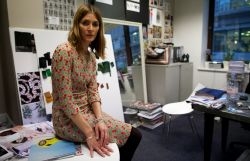Topshop: playing with the big boys but keeping it real

Drawing on classic floral prints and school uniforms, “dishevelled elegance” is this season’s theme for Unique, the top-end line by the British high-street chain which holds its catwalk show on Sunday.
“We’re looking at this old etiquette book we found, it’s called ‘How to be a lady’. With our Unique girl, we’re saying it’s ‘How NOT to be a lady’,” head of design Emma Farrow told AFP a few days before the show.
Founded 50 years ago in the basement of a department store in Sheffield, northern England, Topshop has undergone a remarkable transformation in the past decade to become a global fashion player, a purveyor of cutting-edge style and a sponsor of new talent.
The company has expanded beyond its teen base to attract fashionistas of all ages, helped by lines such as Unique, offering “more refined” pieces at mid-range prices.
But despite the catwalk show and plans to open a 40,000-square-foot store on New York’s Fifth Avenue this year, Topshop has managed to keep its image as the rebellious little sister of British fashion.
“Our girl is quite tough and cool and a bit adrogynous but she’s still got a bit of an edge to her, she likes to dress up to go out,” said Farrow, 39.
This image will be reinforced in April’s collection by Moss, the uber-cool British model who is resuming her collaboration with Topshop after a break of four years.
Farrow was tight-lipped about its content, but said: “It’s very exciting. I’ve seen it, it’s incredible. It’s very new but still the essence of her.
“It’s going to come from a very different place that I think will really excite customers.”
Philip Green, the owner of Topshop and its men’s line Topman, pulled off a major coup in signing up Moss in 2007 for what turned out to be 14 collections over three years.
Other collaborations with designers such as Mary Katrantzou and J.W. Anderson have cemented the brand’s position at the forefront of high-street fashion.
-‘Challenging trading conditions’ –
Topshop is not immune to the tough economic climate and Green admitted in November that trading conditions “remain challenging”.
His company Arcadia, which owns Topshop, the BHS department store and fashion chain Miss Selfridge, reported a 2.7 percent fall in annual like-for-like sales.
But the company is rapidly expanding abroad, fuelled by the December 2012 sale of 25 percent of Topshop and Topman to a US private equity group, Leonard Green and Partners.
Topshop has long had a strong online presence and still attracts people from around the world to its flagship 90,000 square foot Oxford Street store in London.
Now it also has outlets from Japan to Brazil and across the United States, through a partnership with US department store Nordstrom and several stand-alone stores.
– ‘Backing new talent’ –
Down the road from the Oxford Street store, at Topshop HQ, a small army of designers produce 300 different lines that go into stores every week, everything from coats to shoes, lingerie and make-up.
The sheer range and the rapid response to catwalk trends are key to the company’s success, but it has also built a powerful brand that elevates it above the raft of high-street chains ripping off top designers.
“I don’t think people come to us for a look, a top-to-toe outfit that was shown in Vogue. They come to us to live a story for the season,” said Farrow, tall and willowy in a floral print Jill Stuart dress.
Nowhere is Topshop’s influence more evident than at London Fashion Week, where it sponsors up-and-coming designers to hold their own shows through the NewGen scheme.
Past NewGen beneficiaries include Alexander McQueen, Christopher Kane and Mary Katrantzou, while this year’s winners include Simone Rocha and Marques’Almeida.
Unique’s show is also one of the hottest tickets in town, last season featuring Cara Delevingne and drawing Anna Wintour of American Vogue to the front row.
Launched in 2001, Unique has been showing in London since 2005. Farrow took over two years ago and, with creative director Kate Phelan, ditched some of the more wacky designs of the past, such as fluffy animal hats.
“It has to be, for me, the essence of what I’d like to wear,” Farrow said.

